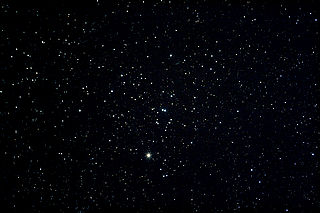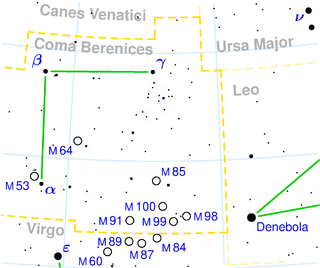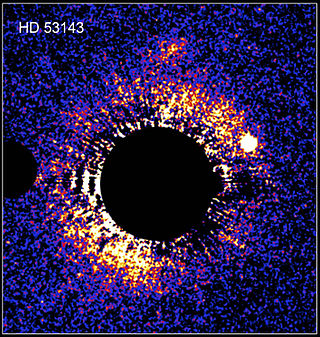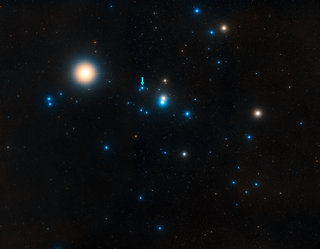
61 Cygni is a binary star system in the constellation Cygnus, consisting of a pair of K-type dwarf stars that orbit each other in a period of about 659 years. Of apparent magnitude 5.20 and 6.05, respectively, they can be seen with binoculars in city skies or with the naked eye in rural areas without light pollution.

The Hyades is the nearest open cluster and one of the best-studied star clusters. Located about 153 light-years away from the Sun, it consists of a roughly spherical group of hundreds of stars sharing the same age, place of origin, chemical characteristics, and motion through space. From the perspective of observers on Earth, the Hyades Cluster appears in the constellation Taurus, where its brightest stars form a "V" shape along with the still-brighter Aldebaran. However, Aldebaran is unrelated to the Hyades, as it is located much closer to Earth and merely happens to lie along the same line of sight.

The Beehive Cluster, is an open cluster in the constellation Cancer. One of the nearest open clusters to Earth, it contains a larger population of stars than other nearby bright open clusters holding around 1,000 stars. Under dark skies, the Beehive Cluster looks like a small nebulous object to the naked eye, and has been known since ancient times. Classical astronomer Ptolemy described it as a "nebulous mass in the breast of Cancer". It was among the first objects that Galileo studied with his telescope.

Messier 67 and sometimes called the King Cobra Cluster or the Golden Eye Cluster is an open cluster in the southern, equatorial half of Cancer. It was discovered by Johann Gottfried Koehler in 1779. Estimates of its age range between 3.2 and 5 billion years. Distance estimates are likewise varied, but typically are 800–900 parsecs (2,600–2,900 ly). Estimates of 855, 840, and 815 pc were established via binary star modelling and infrared color-magnitude diagram fitting.

HD 12661 is a G-type main sequence star in the northern constellation of Aries. The star is slightly larger and more massive than the Sun, with an estimated age of seven billion years. It has two known extrasolar planets.

Beta Comae Berenices is a main sequence dwarf star in the northern constellation of Coma Berenices. It is located at a distance of about 29.95 light-years from Earth. The Greek letter beta (β) usually indicates that the star has the second highest visual magnitude in the constellation. However, with an apparent visual magnitude of 4.3, this star is actually slightly brighter than α Comae Berenices. It can be seen with the naked eye, but may be too dim to be viewed from a built-up urban area.

Sigma Orionis or Sigma Ori is a multiple star system in the constellation Orion, consisting of the brightest members of a young open cluster. It is found at the eastern end of the belt, south west of Alnitak and west of the Horsehead Nebula which it partially illuminates. The combined brightness of the component stars is magnitude 3.80.
Gliese 673 is an orange dwarf star in the constellation Ophiuchus. It has a stellar classification of K7V. Main sequence stars with this spectra have a mass in the range of 60–70% of solar mass (M☉).
HR 1614 is a star in the constellation Eridanus. Based upon parallax measurements, it is about 28.8 light-years distant from the Earth. It is a main sequence star with a stellar classification of K3V. The chromosphere has an effective temperature of about 4,945 K, which gives this star the orange hue characteristic of K-type stars. It has about 84% of the Sun's mass and 78% of the Sun's radius.

71 Tauri is a suspected triple star system in the zodiac constellation Taurus, located 146 light years from the Sun. It is visible to the naked eye as a faint, yellow-white hued star with an apparent visual magnitude of +4.48. The star is moving further away from the Earth with a heliocentric radial velocity of +38 km/s. It is a member of the Hyades open cluster.

Stellar rotation is the angular motion of a star about its axis. The rate of rotation can be measured from the spectrum of the star, or by timing the movements of active features on the surface.

HD 53143 is a star in the Carina constellation, located about 59.8 light-years from the Earth. With an apparent visual magnitude of 6.80, this star is a challenge to view with the naked eye even under ideal viewing conditions.

SZ Crateris is a binary star system in the southern constellation Crater. Both components belong to the main sequence: the primary star has a spectral classification of K5V while the secondary is a red dwarf of spectral class M0V. The radius of the primary is about 66% the radius of the Sun, while the secondary member is only about 42% of the solar radius. In 1994, the two stars were separated by 5.1 arc seconds, which is equivalent to 112.41 astronomical units.

111 Tauri is a wide binary star system in the constellation Taurus. It is located at a distance of 48 light years from the Sun. Primary component A is a main sequence star with a stellar classification of F8V. The secondary component B is a K-type main sequence star. The primary is larger and more luminous than the Sun, with about 130% of the Sun's radius and 185% of the Sun's luminosity. The apparent magnitude of 5.0 indicates it is a faint star that can be viewed by the naked eye under good, dark-sky conditions.

HD 28527 is a star in the constellation Taurus, and a member of the Hyades open cluster. It is faintly visible to the naked eye with an apparent visual magnitude of 4.78. The distance to this star, as determined from its parallax shift of 22 mas, is 148 light years. It is moving away from the Earth with a heliocentric radial velocity of +38 km/s.
56 Cygni is a single star in the northern constellation of Cygnus, located 135 light years from Earth. It is visible to the naked eye as a white-hued star with an apparent visual magnitude of 5.06. The star is moving closer to the Earth with a heliocentric radial velocity of −21.5. It has a relatively high proper motion, traversing the celestial sphere at an angular rate of 0.181″/yr. According to Eggen (1998), this is a member of the Hyades Supercluster.

NGC 6388 is a globular cluster of stars located in the southern constellation of Scorpius. The cluster was discovered by Scottish astronomer James Dunlop on May 13, 1826 using a 20 cm (9 in) reflector telescope. It was later determined to be a globular cluster by English astronomer John Herschel, who was able to resolve it into individual stars. NGC 6388 is located at a distance of approximately 35,600 light-years (10.90 kpc) from the Sun. Due to its apparent visual magnitude of +6.8, binoculars or a small telescope are required to view it.

HK Aquarii is a single variable star in the equatorial constellation of Aquarius. It is invisible to the naked eye, having an average apparent visual magnitude that fluctuates around 10.99. The star is located at a distance of 81 light years from the Sun based on parallax. The radial velocity is poorly constrained but it appears to be drifting further away at a rate of ~2 km/s.

V957 Scorpii is a variable star in the constellation of Scorpius. It is a blue straggler in the open cluster Messier 7, a star that is unexpectedly hot compared to other members of the cluster.

79 Tauri, also known as b Tauri, is an Am star in the constellation of Taurus with an apparent magnitude of 5.0. It is a member of the Hyades open cluster and parallax measurements by Gaia give a distance of about 157 light years.
















